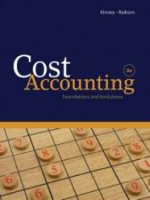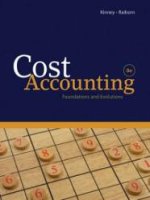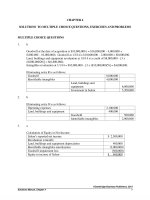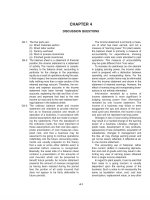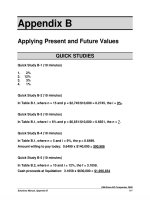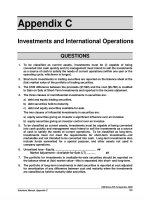Solution manual financial accounting 8e by libby ch04
Bạn đang xem bản rút gọn của tài liệu. Xem và tải ngay bản đầy đủ của tài liệu tại đây (2.6 MB, 80 trang )
Find more at www.downloadslide.com
Chapter 04 - Adjustments, Financial Statements, and the Quality of Earnings
Chapter 4
Adjustments, Financial Statements, and the
Quality of Earnings
ANSWERS TO QUESTIONS
1. Adjusting entries are made at the end of the accounting period to record all
revenues and expenses that have not been recorded but belong in the current
period. They update the balance sheet and income statement accounts at the end
of the accounting period.
2. The four different types are adjustments for:
(1) Deferred revenues -- previously recorded liabilities that need to be adjusted at
the end of the period to reflect revenues that have been earned (e.g., Unearned
Ticket Revenue must be adjusted for the portion of ticket revenues earned in
the current period).
(2) Accrued revenues -- revenues that have been earned by the end of the
accounting period but which will be collected in a future accounting period (e.g.,
recording Interest Receivable for interest revenues not yet collected).
(3) Deferred expenses -- previously recorded assets that need to be adjusted at the
end of the period to reflect incurred expenses (e.g., Prepaid Insurance must be
adjusted for the portion of insurance expense incurred in the current period).
(4) Accrued expenses -- expenses that have been incurred by the end of the
accounting period but which will be paid in a future accounting period (e.g.,
recording Utilities Payable for utilities expense incurred during the period that
has not yet been paid).
3. A contra-asset is an account related to an asset that is an offset or reduction to the
asset's balance. Accumulated Depreciation is a contra-account to the equipment
and buildings accounts.
Financial Accounting, 8/e
4-1
© 2014 by McGraw-Hill Global Education Holdings, LLC. This is proprietary material solely for authorized instructor use. Not authorized for sale or distribution in
any manner. This document may not be copied, scanned, duplicated, forwarded, distributed, or posted on a website, in whole or part.
Find more at www.downloadslide.com
Chapter 04 - Adjustments, Financial Statements, and the Quality of Earnings
4. The net income on the income statement is included in determining ending retained
earnings on the statement of stockholders’ equity and the balance sheet. The
change in the cash account on the balance sheet is analyzed and categorized on
the statement of cash flows into cash from operating activities, investing activities,
and financing activities.
5. (a) Income statement: Revenues (and gains) - Expenses (and losses) = Net Income
(b) Balance sheet: Assets = Liabilities + Stockholders' Equity
(c) Statement of stockholders' equity: Ending Stockholders' Equity = (Beginning
Contributed Capital + Stock Issuances - Stock Repurchases) + (Beginning
Retained Earnings + Net Income - Dividends Declared)
6. Adjusting entries have no effect on cash. For deferred revenues and deferred
expenses, cash was received or paid at some point in the past. For accruals, cash
will be received or paid in a future accounting period. At the time of the adjusting
entry, there is no cash being received or paid.
7. Earnings per share = Net income ÷ average number of shares of stock outstanding
during the period.
Earnings per share measures the average amount of net income for the year
attributable to one share of common stock.
8. Total asset turnover ratio = Sales (or Operating) Revenues ÷ Average Total Assets
The total asset turnover ratio measures sales generated during the period per dollar
of assets – how effective the company is at generating sales by utilizing assets.
9. The closing entry is made at the end of the accounting period to (1) transfer the
balances in the temporary income statement accounts to retained earnings and (2)
reduce the revenue, gain, expense, and loss accounts to a zero balance so that they
can be used for the accumulation process during the next period. A closing entry
must be entered into the system through the journal and posted to the ledger
accounts to state properly the temporary and permanent account balances (i.e., zero
balances in the temporary accounts).
10. (a) Permanent accounts -- balance sheet accounts; that is, the asset, liability, and
stockholders’ equity accounts (these are not closed at the end of each period).
(b) Temporary accounts -- income statement accounts; that is, revenues, gains,
expenses, and losses (these are closed at the end of each period).
(c) Real accounts -- another name for permanent accounts.
(d) Nominal accounts -- another name for temporary accounts.
4-2
Solutions Manual
© 2014 by McGraw-Hill Global Education Holdings, LLC. This is proprietary material solely for authorized instructor use. Not authorized for sale or distribution in
any manner. This document may not be copied, scanned, duplicated, forwarded, distributed, or posted on a website, in whole or part.
Find more at www.downloadslide.com
Chapter 04 - Adjustments, Financial Statements, and the Quality of Earnings
11. The income statement accounts are closed at the end of the accounting period
because, in effect, they are temporary subaccounts to retained earnings (i.e., a part
of stockholders' equity). They are used only for accumulation during the accounting
period. When the period ends, these accumulated accounts must be transferred
(closed) to retained earnings. The closing process serves:
(1) to correctly state retained earnings, and
(2) to clear out the balances of the temporary accounts for the year just ended so
that these subaccounts can be used again during the next period for
accumulation and classification purposes.
Balance sheet accounts are not closed at the end of the period because they reflect
permanent accumulated balances of assets, liabilities, and stockholders' equity.
Permanent accounts show the entity's financial position at the end of the period and
are the beginning amounts for the next period.
12. A post-closing trial balance is a listing taken from the ledger after the adjusting and
closing entries have been journalized and posted. It is not a necessary part of the
accounting information processing cycle but it is useful because it demonstrates the
equality of the debits and credits in the ledger after the closing entry has been
journalized and posted and that all temporary accounts have zero balances.
Financial Accounting, 8/e
4-3
© 2014 by McGraw-Hill Global Education Holdings, LLC. This is proprietary material solely for authorized instructor use. Not authorized for sale or distribution in
any manner. This document may not be copied, scanned, duplicated, forwarded, distributed, or posted on a website, in whole or part.
Find more at www.downloadslide.com
Chapter 04 - Adjustments, Financial Statements, and the Quality of Earnings
ANSWERS TO MULTIPLE CHOICE
1.
2.
3.
4.
5.
6.
7.
8.
9.
10.
4-4
c
b
b
b
b
c
c
c
c
c
Solutions Manual
© 2014 by McGraw-Hill Global Education Holdings, LLC. This is proprietary material solely for authorized instructor use. Not authorized for sale or distribution in
any manner. This document may not be copied, scanned, duplicated, forwarded, distributed, or posted on a website, in whole or part.
Find more at www.downloadslide.com
Chapter 04 - Adjustments, Financial Statements, and the Quality of Earnings
Authors' Recommended Solution Time
(Time in minutes)
Mini-exercises
No.
Time
1
5
2
5
3
3
4
5
5
5
6
5
7
5
8
5
9
5
10
5
11
5
12
3
Exercises
No. Time
1
10
2
10
3
10
4
15
5
10
6
20
7
20
8
20
9
15
10
20
11
10
12
20
13
15
14
15
15
20
16
20
17
20
18
20
19
10
20
15
Problems
No.
Time
1
15
2
20
3
20
4
20
5
20
6
25
7
30
Alternate
Problems
No.
Time
1
15
2
20
3
20
4
20
5
20
6
25
7
30
Comprehensive
Problems
No.
Time
1
60
2
60
Cases and
Projects
No.
Time
1
25
2
25
3
25
4
20
5
25
6
40
7
35
8
50
9
25
10
*
Continuing
Case
1
15
* Due to the nature of this project, it is very difficult to estimate the amount of time
students will need to complete the assignment. As with any open-ended project, it is
possible for students to devote a large amount of time to these assignments. While
students often benefit from the extra effort, we find that some become frustrated by the
perceived difficulty of the task. You can reduce student frustration and anxiety by
making your expectations clear. For example, when our goal is to sharpen research
skills, we devote class time to discussing research strategies. When we want the
students to focus on a real accounting issue, we offer suggestions about possible
companies or industries.
Financial Accounting, 8/e
4-5
© 2014 by McGraw-Hill Global Education Holdings, LLC. This is proprietary material solely for authorized instructor use. Not authorized for sale or distribution in
any manner. This document may not be copied, scanned, duplicated, forwarded, distributed, or posted on a website, in whole or part.
Find more at www.downloadslide.com
Chapter 04 - Adjustments, Financial Statements, and the Quality of Earnings
MINI-EXERCISES
M4–1.
Hagadorn Company
Adjusted Trial Balance
At June 30, 2014
Debit
Cash
Accounts receivable
Inventories
Prepaid expenses
Buildings and equipment
Accumulated depreciation
Land
Accounts payable
Accrued expenses payable
Income taxes payable
Unearned fees
Long-term debt
Common stock
Additional paid-in capital
Retained earnings
Sales revenue
Interest income
Cost of sales
Salaries expense
Rent expense
Depreciation expense
Interest expense
Income taxes expense
Totals
$
Credit
175
420
710
30
1,400
$
250
300
250
160
50
90
1,460
100
300
150
2,400
60
780
640
460
150
70
135
$ 5,270
$ 5,270
M4–2.
(1) D
(2) C
(3) A
(4) D
(5) A
(6) B
(7) B
(8) C
4-6
Solutions Manual
© 2014 by McGraw-Hill Global Education Holdings, LLC. This is proprietary material solely for authorized instructor use. Not authorized for sale or distribution in
any manner. This document may not be copied, scanned, duplicated, forwarded, distributed, or posted on a website, in whole or part.
Find more at www.downloadslide.com
Chapter 04 - Adjustments, Financial Statements, and the Quality of Earnings
M4–3.
(1) D
(2) C
(3) A
(4) B
M4–4.
(a) 1. Rent revenue is now earned.
2. Cash was received in the past – a deferred revenue was recorded.
3. Amount: $1,200 4 months = $300 earned
Adjusting entry –
Unearned rent revenue (L) .........................
Rent revenue (+R, +SE) .......................
300
300
(b) 1. Depreciation Expense on the equipment is now incurred.
2. Cash was paid in the past when the equipment was purchased -- a deferred
expense was recorded. The net book value of the equipment is overstated.
Accumulated Depreciation (the contra-account) needs to be increased for
the amount used during the period.
3. Amount: $3,200 given
Adjusting entry –
Depreciation expense (+E, SE) .................
Accumulated depreciation (+XA, A) ....
3,200
3,200
(c) 1. Insurance expense was incurred in the period.
2. Cash was paid for the insurance in the past – a deferred expense was
recorded.
3. Amount: $5,000 x 6/24 = $1,250
Adjusting entry –
Insurance expense (+E, SE) ......................
Prepaid insurance (A) .........................
Financial Accounting, 8/e
1,250
1,250
4-7
© 2014 by McGraw-Hill Global Education Holdings, LLC. This is proprietary material solely for authorized instructor use. Not authorized for sale or distribution in
any manner. This document may not be copied, scanned, duplicated, forwarded, distributed, or posted on a website, in whole or part.
Find more at www.downloadslide.com
Chapter 04 - Adjustments, Financial Statements, and the Quality of Earnings
M4–5.
Balance Sheet
Stockholders’
Liabilities
Equity
–300
+300
Income Statement
Revenues Expenses
+300
NE
Net
Income
+300
Transaction
a.
Assets
NE
b.
–3,200
NE
–3,200
NE
+3,200
–3,200
c.
–1,250
NE
–1,250
NE
+1,250
–1,250
M4–6.
(a) 1. Utilities Expense is incurred.
2. Cash will be paid in the future for utilities used in the current period – an
accrued expense needs to be recorded.
3. Amount: $450 given
Adjusting entry –
Utilities expense (+E, SE) ..........................
Utilities payable (+L) .............................
450
450
(b) 1. Interest revenue is now earned on the note receivable.
2. Cash for the interest will be received in the future – an accrued revenue
needs to be recorded.
3. Amount: $6,000 principal x .14 annual rate x 4/12 of a year = $280
Adjusting entry –
Interest receivable (+A) ...............................
Interest revenue (+R, +SE)...................
280
280
(c) 1. Wages expense was incurred in the period.
2. Cash will be paid in the future to the employees who worked in the current
period – an accrued expense needs to be recorded.
3. Amount: 10 employees x 4 days x $200 per day = $8,000
Adjusting entry –
Wages expense (+E, SE) ..........................
Wages payable (+L) .............................
4-8
8,000
8,000
Solutions Manual
© 2014 by McGraw-Hill Global Education Holdings, LLC. This is proprietary material solely for authorized instructor use. Not authorized for sale or distribution in
any manner. This document may not be copied, scanned, duplicated, forwarded, distributed, or posted on a website, in whole or part.
Find more at www.downloadslide.com
Chapter 04 - Adjustments, Financial Statements, and the Quality of Earnings
M4–7.
Balance Sheet
Stockholders’
Liabilities
Equity
+450
–450
Income Statement
Revenues Expenses
NE
+450
Net
Income
–450
Transaction
a.
Assets
NE
b.
+280
NE
+280
+280
NE
+280
c.
NE
+8,000
–8,000
NE
+8,000
–8,000
M4–8.
ROMNEY’S MARKETING COMPANY
Income Statement
For the Year Ended December 31, 2015
Operating Revenues:
Sales revenue
Total operating revenues
Operating Expenses:
Wages expense
Depreciation expense
Utilities expense
Insurance expense
Rent expense
Total operating expenses
Operating Income
Other Items:
Interest revenue
Rent revenue
Pretax Income
Income tax expense
Net Income
$ 38,500
38,500
19,500
1,800
380
750
9,000
31,430
7,070
$
Earnings per share*
100
800
7,970
2,700
5,270
$9.58
* calculated as $5,270 [(300 + 800) 2] = $5,270 550 = $9.58
Average number of shares
Financial Accounting, 8/e
4-9
© 2014 by McGraw-Hill Global Education Holdings, LLC. This is proprietary material solely for authorized instructor use. Not authorized for sale or distribution in
any manner. This document may not be copied, scanned, duplicated, forwarded, distributed, or posted on a website, in whole or part.
Find more at www.downloadslide.com
Chapter 04 - Adjustments, Financial Statements, and the Quality of Earnings
M4–9.
ROMNEY’S MARKETING COMPANY
Statement of Stockholders’ Equity
For the Year Ended December 31, 2015
Balance, January 1, 2015
Share issuance
Net income
Dividends declared
Balance, December 31, 2015
4-10
Additional
Paid-in
Capital
$ 670
2,950
Total
Common
Retained
Stockholders’
Stock
Earnings
Equity
$ 30
$ 2,000*
$ 2,700
50
3,000
5,270
5,270
(0)
(0)
$ 80
$ 3,620
$ 7,270
$ 10,970
*From the trial balance.
Work backwards
Solutions Manual
© 2014 by McGraw-Hill Global Education Holdings, LLC. This is proprietary material solely for authorized instructor use. Not authorized for sale or distribution in
any manner. This document may not be copied, scanned, duplicated, forwarded, distributed, or posted on a website, in whole or part.
Find more at www.downloadslide.com
Chapter 04 - Adjustments, Financial Statements, and the Quality of Earnings
M4–10.
Req. 1
ROMNEY’S MARKETING COMPANY
Balance Sheet
At December 31, 2015
Assets
Current Assets:
Cash
Accounts receivable
Interest receivable
Prepaid insurance
Total current assets
Notes receivable
Equipment (net of accumulated depreciation, $3,000)
Total Assets
Liabilities
Current Liabilities:
Accounts payable
Accrued expenses payable
Income taxes payable
Unearned rent revenue
Total current liabilities
Stockholders’ Equity
Common stock ($0.10 par value)
Additional paid-in capital
Retained earnings
Total Stockholders’ Equity
Total Liabilities and Stockholders’ Equity
$
1,500
2,200
100
1,600
5,400
2,800
12,290
$ 20,490
$ 2,400
3,920
2,700
500
9,520
80
3,620
7,270
10,970
$ 20,490
Req. 2
The adjustments in M4–4 and M4–6 have no effect on the operating, investing, and
financing activities on the statement of cash flows because no cash is paid or received
at the time of the adjusting entries.
Financial Accounting, 8/e
4-11
© 2014 by McGraw-Hill Global Education Holdings, LLC. This is proprietary material solely for authorized instructor use. Not authorized for sale or distribution in
any manner. This document may not be copied, scanned, duplicated, forwarded, distributed, or posted on a website, in whole or part.
Find more at www.downloadslide.com
Chapter 04 - Adjustments, Financial Statements, and the Quality of Earnings
M4–11.
Assets:
Cash
Accounts receivable
Interest receivable
Prepaid insurance
Notes receivable
Equipment
Accumulated depreciation
Total assets
$ 1,500
2,200
100
1,600
2,800
15,290
(3,000)
$ 20,490
Total asset turnover = Sales (or Operating) revenues Average total assets
= $38,500 $18,270 = 2.11
($16,050 + $20,490)/2 = $18,270
M4–12.
Sales revenue (R) ................................................
Interest revenue (R) .............................................
Rent revenue (R) .................................................
Retained earnings (+SE) ..............................
Wages expense (E) ...................................
Depreciation expense (E) ..........................
Utilities expense (E) ...................................
Insurance expense (E) ...............................
Rent expense (E) ......................................
Income tax expense (E) .............................
4-12
38,500
100
800
5,270
19,500
1,800
380
750
9,000
2,700
Solutions Manual
© 2014 by McGraw-Hill Global Education Holdings, LLC. This is proprietary material solely for authorized instructor use. Not authorized for sale or distribution in
any manner. This document may not be copied, scanned, duplicated, forwarded, distributed, or posted on a website, in whole or part.
Find more at www.downloadslide.com
Chapter 04 - Adjustments, Financial Statements, and the Quality of Earnings
EXERCISES
E4–1.
Paige Consultants, Inc.
Unadjusted Trial Balance
At September 30, 2015
Debit
Cash
Accounts receivable
Supplies
Prepaid expenses
Investments
Buildings and equipment
Accumulated depreciation
Land
Accounts payable
Accrued expenses payable
Unearned consulting fees
Income taxes payable
Notes payable
Common stock
Additional paid-in capital
Retained earnings *
Consulting fees revenue
Investment income
Gain on sale of land
Wages and benefits expense
Utilities expense
Travel expense
Rent expense
Professional development expense
Other operating expenses
General and administrative expenses
Interest expense
Totals
Credit
$ 153,000
225,400
12,200
10,200
145,000
323,040
$
18,100
60,000
96,830
25,650
32,500
3,030
160,000
3,370
220,000
144,510
2,564,200
10,800
6,000
1,610,000
25,230
23,990
152,080
18,600
188,000
321,050
17,200
$3,284,990
$3,284,990
* Since debits are supposed to equal credits in a trial balance, the balance in Retained
Earnings is determined as the amount in the credit column necessary to make debits
equal credits (a “plugged” figure).
Financial Accounting, 8/e
4-13
© 2014 by McGraw-Hill Global Education Holdings, LLC. This is proprietary material solely for authorized instructor use. Not authorized for sale or distribution in
any manner. This document may not be copied, scanned, duplicated, forwarded, distributed, or posted on a website, in whole or part.
Find more at www.downloadslide.com
Chapter 04 - Adjustments, Financial Statements, and the Quality of Earnings
E4–2.
Req. 1
Types
Deferred Revenues:
Deferred Revenue may need to be
adjusted for any revenue earned
during the period
Accrued Revenues:
Interest may be earned on Short-term
Investments
Accounts to be Adjusted
Deferred Revenue (L) and Product
Revenue and/or Service Revenue (R)
Interest Receivable (A) and Interest
Revenue (R)
Any unrecorded sales or services
provided will need to be recorded
Accounts Receivable (A) and Product
Revenue and/or Service Revenue (R)
Deferred Expenses:
Other Current Assets may include
supplies, prepaid rent, prepaid
insurance, or prepaid advertising
Other Current Assets (A) and Selling,
General, and Administrative Expense
(E)
Any additional use of Property, Plant,
and Equipment during the period
will need to be recorded
Accrued Expenses:
Interest incurred on Short-term Note
Payable and Long-term Debt will
need to be recorded
Accumulated Depreciation (XA) and Cost
of Products and/or Cost of Services
(E)
Accrued Liabilities (L) and Interest
Expense (E)
There are likely many other accrued
expenses to be recorded,
including wages, warranties, and
utilities; pension, and
contingencies
Accrued Liabilities (L) and Selling,
General, and Administrative Expenses
(among other expenses) (E); Other
Liabilities (L) (pension and
contingencies among other expenses)
Income taxes must be computed for
the period and accrued
Income Tax Payable (L) and Income Tax
Expense (E)
Req. 2
Temporary accounts that accumulate during the period are closed at the end of the year
to the permanent account Retained Earnings. These include: Product revenue, service
revenue, interest revenue, cost of products, cost of services, interest expense, research
and development expense, selling, general, and administrative expense, other
expenses, and income tax expense.
4-14
Solutions Manual
© 2014 by McGraw-Hill Global Education Holdings, LLC. This is proprietary material solely for authorized instructor use. Not authorized for sale or distribution in
any manner. This document may not be copied, scanned, duplicated, forwarded, distributed, or posted on a website, in whole or part.
Find more at www.downloadslide.com
Chapter 04 - Adjustments, Financial Statements, and the Quality of Earnings
E4–3.
Req. 1
The annual reporting period for this company is January 1 through December 31, 2014.
Req. 2 (Adjusting entries)
Both transactions are accruals because revenue has been earned and expenses
incurred but no cash has yet been received or paid.
(a) 1. Wages expense is incurred.
2. Cash will be paid in the next period to employees who worked in the current
period – an accrued expense needs to be recorded.
3. Amount: $4,000 given
Adjusting entry – December 31, 2014
Wages expense (+E, SE) ..........................
Wages payable (+L) .............................
To record wages accrued at year-end.
4,000
4,000
(b) 1. Interest revenue is now earned.
2. Cash will be received in the future – an accrued revenue needs to be
recorded.
3. Amount: $1,500 given
Adjusting entry – December 31, 2014
Interest receivable (+A) ...............................
Interest revenue (+R, +SE) ...................
To record interest earned at year-end.
1,500
1,500
Req. 3
Adjusting entries are necessary at the end of the accounting period to ensure that all
revenues earned and expenses incurred and the related assets and liabilities are
measured properly. The entries above are accruals; entry (a) is an accrued expense
(incurred but not yet recorded) and entry (b) is an accrued revenue (earned but not yet
recorded). In applying the accrual basis of accounting, revenues should be recognized
when earned and measurable and expenses should be recognized when incurred in
generating revenues.
Financial Accounting, 8/e
4-15
© 2014 by McGraw-Hill Global Education Holdings, LLC. This is proprietary material solely for authorized instructor use. Not authorized for sale or distribution in
any manner. This document may not be copied, scanned, duplicated, forwarded, distributed, or posted on a website, in whole or part.
Find more at www.downloadslide.com
Chapter 04 - Adjustments, Financial Statements, and the Quality of Earnings
E4–4.
Req. 1
Prepaid Insurance is a deferred expense that needs to be adjusted each period for the
amount used during the period.
The amount of expense is computed as follows: $4,800 x 3/24 = $600 used
Adjusting entry:
Insurance expense (+E, SE) .....................................
Prepaid insurance (A) ....................................
600
600
Req. 2
Shipping Supplies is a deferred expense that needs to be adjusted at the end of the
period for the amount of supplies used during the period.
The amount is computed as follows: Beginning balance
Supplies purchased
Supplies on hand at end
Supplies used
Adjusting entry:
Shipping supplies expense (+E, SE) .........................
Shipping supplies (A) .....................................
$13,000
75,000
(20,000)
$68,000
68,000
68,000
Req. 3
Prepaid Insurance
10/1 4,800
AJE 600
End.
4,200
Shipping Supplies
Beg. 13,000
Purch. 75,000 AJE 68,000
End. 20,000
Insurance Expense
AJE
End.
600
600
Shipping Supplies Expense
AJE 68,000
End. 68,000
2014 Income statement:
Insurance expense
$ 600
Shipping supplies expense $68,000
Req. 4
2014 Balance sheet:
Prepaid insurance $ 4,200
Shipping supplies $20,000
4-16
Solutions Manual
© 2014 by McGraw-Hill Global Education Holdings, LLC. This is proprietary material solely for authorized instructor use. Not authorized for sale or distribution in
any manner. This document may not be copied, scanned, duplicated, forwarded, distributed, or posted on a website, in whole or part.
Find more at www.downloadslide.com
Chapter 04 - Adjustments, Financial Statements, and the Quality of Earnings
E4–5.
Transaction Assets
E4–3 (a)
NE
E4–3 (b)
+1,500
E4–4 (a)
–600
E4–4 (b)
–68,000
Balance Sheet
Stockholders’
Liabilities
Equity
+4,000
–4,000
NE
+1,500
NE
–600
NE
–68,000
Income Statement
Net
Revenues Expenses Income
NE
+4,000
–4,000
+1,500
NE
+1,500
NE
+600
–600
NE
+68,000
–68,000
E4–6.
Req. 1
a.
b.
c.
d.
e.
f.
g.
Accrued expense
Deferred expense
Accrued revenue
Deferred expense
Deferred expense
Deferred revenue
Accrued revenue
Req. 2
a.
2,700
Wages expense (+E, SE) ..........................................
Wages payable (+L) .......................................... 2,700
Computations
Given
b.
675
Office supplies expense (+E, SE) ..............................
Office supplies (A) ........................................... 675
$450 + $500
- $275 = $675 used
c.
Rent receivable (+A) ...................................................
1,120
Rent revenue (+R, +SE) .................................... 1,120
$560 x 2 months
= $1,120 earned
d.
12,100
Depreciation expense (+E, SE) .................................
12,100
Accumulated depreciation (+XA, A)
Given
e.
600
Insurance expense (+E, SE) ......................................
Prepaid insurance (A) ...................................... 600
$2,400 x 6/24 =
$600 used
f.
3,200
Unearned rent revenue (L) ........................................
Rent revenue (+R, +SE) .................................... 3,200
$9,600 x 2/6 =
$3,200 earned
g.
Repair accounts receivable (+A)..................................
800
Repair shop revenue (+R, +SE) ........................ 800
Given
Financial Accounting, 8/e
4-17
© 2014 by McGraw-Hill Global Education Holdings, LLC. This is proprietary material solely for authorized instructor use. Not authorized for sale or distribution in
any manner. This document may not be copied, scanned, duplicated, forwarded, distributed, or posted on a website, in whole or part.
Find more at www.downloadslide.com
Chapter 04 - Adjustments, Financial Statements, and the Quality of Earnings
E4–7.
Req. 1
a.
b.
c.
d.
e.
f.
g.
Accrued revenue
Deferred expense
Accrued expense
Deferred revenue
Deferred expense
Deferred expense
Accrued expense
Req. 2
a.
Accounts receivable (+A) ............................................
3,300
Service revenue (+R, +SE) ............................... 3,300
Computations
Given
b.
1,650
Advertising expense (+E, SE)....................................
Prepaid advertising (A) .................................... 1,650
$2,200 x 9/12 =
$1,650 used
c.
5,500
Interest expense (+E, SE) .........................................
Interest payable (+L) ......................................... 5,500
$300,000 x 0.11
x 2/12 (since last
payment) = $5,500
incurred
d.
750
Unearned storage revenue (L) ...................................
Storage revenue (+R, +SE) ............................... 750
$4,500 x 1/6 =
$750 earned
e.
18,000
Depreciation expense (+E, SE) .................................
18,000
Accumulated depreciation (+XA, A)
Given
f.
48,500
Supplies expense (+E, SE)........................................
Supplies (A).....................................................48,500
$18,900 +
$45,200 – $15,600
= $48,500 used
g.
5,600
Wages expense (+E, SE) ..........................................
Wages payable (+L) .......................................... 5,600
Given
4-18
Solutions Manual
© 2014 by McGraw-Hill Global Education Holdings, LLC. This is proprietary material solely for authorized instructor use. Not authorized for sale or distribution in
any manner. This document may not be copied, scanned, duplicated, forwarded, distributed, or posted on a website, in whole or part.
Find more at www.downloadslide.com
Chapter 04 - Adjustments, Financial Statements, and the Quality of Earnings
E4–8.
Balance Sheet
Stockholders’
Liabilities
Equity
Income Statement
Revenues Expenses
Net
Income
Transaction
Assets
(a)
NE
+2,700
–2,700
NE
+2,700
–2,700
(b)
–675
NE
–675
NE
+675
–675
(c)
+1,120
NE
+1,120
+1,120
NE
+1,120
(d)
–12,100
NE
–12,100
NE
+12,100
–12,100
(e)
–600
NE
–600
NE
+600
–600
(f)
NE
–3,200
+3,200
+3,200
NE
+3,200
(g)
+800
NE
+800
+800
NE
+800
E4–9.
Balance Sheet
Stockholders’
Liabilities
Equity
Income Statement
Transaction
Assets
(a)
+3,300
NE
+3,300
+3,300
NE
+3,300
(b)
–1,650
NE
–1,650
NE
+1,650
–1,650
(c)
NE
+5,500
–5,500
NE
+5,500
–5,500
(d)
NE
–750
+750
+750
NE
+750
(e)
–18,000
NE
–18,000
NE
+18,000
–18,000
(f)
–48,500
NE
–48,500
NE
+48,500
–48,500
(g)
NE
+5,600
–5,600
NE
+5,600
–5,600
Financial Accounting, 8/e
Revenues Expenses
Net
Income
4-19
© 2014 by McGraw-Hill Global Education Holdings, LLC. This is proprietary material solely for authorized instructor use. Not authorized for sale or distribution in
any manner. This document may not be copied, scanned, duplicated, forwarded, distributed, or posted on a website, in whole or part.
Find more at www.downloadslide.com
Chapter 04 - Adjustments, Financial Statements, and the Quality of Earnings
E4–10.
a.
Independent Situations
Accrued wages, unrecorded and unpaid at
year-end, $400 (example).
Debit
Code Amount
N
400
Credit
Code Amount
G
400
b.
Service revenue earned but not yet
collected at year-end, $600.
C
600
L
600
c.
Dividends declared and paid during the
year, $900.
K
900
A
900
d.
Office supplies on hand during the year,
$400; supplies on hand at year-end, $160.
Q
240
B
240
e.
Service revenue collected in advance and
not yet earned, $800.
A
800
I
800
f.
Depreciation expense for the year, $1,000.
O
1,000
E
1,000
g.
At year-end, interest on note payable not
yet recorded or paid, $220.
P
220
H
220
h.
Balance at year-end in Service Revenue
account, $56,000. Prepare the closing
entry at year-end.
L
56,000
K
56,000
i.
Balance at year-end in Interest Expense
account, $460. Prepare the closing entry at
year-end.
K
460
P
460
E4–11.
Selected Balance Sheet Amounts at December 31, 2015
Assets:
Equipment (recorded at cost per cost principle)
Accumulated depreciation (for one year, as given)
Net book value of equipment (difference)
$25,000
(2,500)
22,500
Office supplies (on hand, as given)
800
Prepaid insurance (remaining coverage, $1,000 x 18/24
months)
750
Selected Income Statement Amounts for the Year Ended December 31, 2015
Expenses:
Depreciation expense (for one year, as given)
$ 2,500
Office supplies expense (used, $3,000 - $800 on hand)
2,200
Insurance expense (for 6 months, $1,000 x 6/24 months)
250
4-20
Solutions Manual
© 2014 by McGraw-Hill Global Education Holdings, LLC. This is proprietary material solely for authorized instructor use. Not authorized for sale or distribution in
any manner. This document may not be copied, scanned, duplicated, forwarded, distributed, or posted on a website, in whole or part.
Find more at www.downloadslide.com
Chapter 04 - Adjustments, Financial Statements, and the Quality of Earnings
E4–12.
Balance Sheet
Income Statement
Stockholders’
Net
Assets Liabilities
Equity
Revenues Expenses Income
Date
Note 1:
April 1, 2014
December 31, 2014a
March 31, 2015b
Note 2:
August 1, 2014
NE
NE
NE
NE
NE
NE
+ 2,250
+ 2,250
NE
+ 2,250
NE
+ 750
+750
NE
+ 750
NE
NE
NE
NE
+ 30,000 + 30,000
c
December 31, 2014
January 31, 2015d
+30,000/
–30,000
+ 2,250
+33,000/
–32,250
NE
+ 1,500
- 1,500
NE
+ 1,500
- 1,500
- 31,800
- 31,500
- 300
NE
+ 300
- 300
(a) $30,000 principal x .10 annual interest rate x 9/12 of a year = $2,250
(b) Additional interest revenue in 2015: $30,000 x .10 x 3/12 = $750. Cash received
was $33,000 ($30,000 principal + $3,000 interest for 12 months); receivables
decreased by the $30,000 note receivable and $2,250 interest receivable
accrued in 2014.
(c) $30,000 principal x .12 annual interest rate x 5/12 of a year = $1,500
(d) Additional interest expense in 2015: $30,000 x .12 x 1/12 = $300. Cash paid
was $31,800 ($30,000 principal + $1,800 interest for 6 months); payables
decreased by the $30,000 note payable and $1,500 interest payable accrued in
2014.
Financial Accounting, 8/e
4-21
© 2014 by McGraw-Hill Global Education Holdings, LLC. This is proprietary material solely for authorized instructor use. Not authorized for sale or distribution in
any manner. This document may not be copied, scanned, duplicated, forwarded, distributed, or posted on a website, in whole or part.
Find more at www.downloadslide.com
Chapter 04 - Adjustments, Financial Statements, and the Quality of Earnings
E4–13.
Req. 1
(a)
Cash paid on accrued income taxes payable.
(b)
Accrual of additional income tax expense.
(c)
Cash paid on dividends payable.
(d)
Amount of dividends declared for the period.
(e)
Cash paid on accrued interest payable.
(f)
Accrual of additional interest expense.
Req. 2 Computations:
(a)
Beg. Bal. +
accrued income taxes
$154
+
1,424
-
cash paid
?
?
=
=
=
(c)
Beg. Bal.
$127
dividends declared
634
-
cash paid
?
?
=
=
=
End. bal.
$168
$593 paid
accrued interest expense
?
?
-
cash paid
759
=
=
=
End. bal.
$191
$760 accrued
+
+
(f)
Beg. Bal. +
$190
+
4-22
End. bal.
$166
$1,412 paid
Solutions Manual
© 2014 by McGraw-Hill Global Education Holdings, LLC. This is proprietary material solely for authorized instructor use. Not authorized for sale or distribution in
any manner. This document may not be copied, scanned, duplicated, forwarded, distributed, or posted on a website, in whole or part.
Find more at www.downloadslide.com
Chapter 04 - Adjustments, Financial Statements, and the Quality of Earnings
E4–14.
Req. 1 Adjusting entries that were or should have been made at December 31:
(a) No entry was made. Entry that should have been made:
Rent receivable (+A)...................................................
Rent revenue (+R, +SE) ..................................
1,400
(b) No entry was made. Entry that should have been made:
Depreciation expense (+E, SE) ................................
Accumulated depreciation (+XA, A) …………
15,000
(c) No entry was made. Entry that should have been made:
Unearned fee revenue (L).........................................
Fee revenue (+R, +SE) ....................................
1,500
1,400
15,000
1,500
(d) Entry that was already made:
Interest expense (+E, SE) .......................................
Interest payable (+L) .......................................
($17,000 x .09 x 12/12 months)
1,530
1,530
Entry that should have been made:
Interest expense (+E, SE) ........................................
Interest payable (+L) ........................................
($17,000 x .09 x 2/12 months)
255
255
(e) No entry was made. Entry that should have been made:
Insurance expense (+E, SE) .....................................
Prepaid insurance (A) ....................................
650
650
Req. 2
Balance Sheet
Stockholders’
Liabilities
Equity
Income Statement
Transaction
Assets
(a)
U 1,400
NE
U 1,400
U 1,400
NE
U 1,400
(b)
O 15,000
NE
O 15,000
NE
U 15,000
O 15,000
(c)
NE
O 1,500
U 1,500
U 1,500
NE
U 1,500
(d)
NE
O 1,275
U 1,275
NE
O 1,275
U 1,275
(e)
O 650
NE
O 650
NE
U 650
O 650
Financial Accounting, 8/e
Revenues Expenses
Net
Income
4-23
© 2014 by McGraw-Hill Global Education Holdings, LLC. This is proprietary material solely for authorized instructor use. Not authorized for sale or distribution in
any manner. This document may not be copied, scanned, duplicated, forwarded, distributed, or posted on a website, in whole or part.
Find more at www.downloadslide.com
Chapter 04 - Adjustments, Financial Statements, and the Quality of Earnings
E4–15.
Items
Balances reported
Additional adjustments:
a. Wages
b. Depreciation
c. Rent revenue
Adjusted balances
d. Income taxes
Correct balances
Net
Income
$65,000
(37,000)
(19,000)
3,500
12,500
(3,750)
$ 8,750
Total
Assets
$185,000
Total
Liabilities
$90,000
Stockholders’
Equity
$95,000
37,000
(37,000)
(19,000)
3,500
42,500
(3,750)
$38,750
(19,000)
166,000
$166,000
(3,500)
123,500
3,750
$127,250
Computations:
a.
Given, $37,000 accrued and unpaid.
b.
Given, $19,000 depreciation expense.
c.
$10,500 x 1/3 = $3,500 rent revenue earned. The remaining $7,000 in unearned
revenue is a liability for two months of occupancy "owed'' to the renter.
d.
$12,500 income before taxes x 30% = $3,750.
4-24
Solutions Manual
© 2014 by McGraw-Hill Global Education Holdings, LLC. This is proprietary material solely for authorized instructor use. Not authorized for sale or distribution in
any manner. This document may not be copied, scanned, duplicated, forwarded, distributed, or posted on a website, in whole or part.
Find more at www.downloadslide.com
Chapter 04 - Adjustments, Financial Statements, and the Quality of Earnings
E4–16.
Req. 1
a.
b.
c.
Rent receivable (+A)...................................
Revenues (rent) (+R, +SE) ..................
2,500
Expenses (depreciation) (+E, SE).............
Accumulated depreciation (+XA, A) ...
4,500
Income tax expense (+E, SE) ...................
Income taxes payable (+L) ..................
5,100
2,500
4,500
5,100
Req. 2
Effects of
Adjusting
Entries
As
Prepared
Income statement:
Revenues
Expenses
Income tax expense
Net income
Balance Sheet:
Assets
Cash
Accounts receivable
Rent receivable
Equipment
Accumulated depreciation
Liabilities
Accounts payable
Income taxes payable
Stockholders' Equity
Common stock
Additional paid-in capital
Retained earnings
Financial Accounting, 8/e
$97,000
(73,000)
a
b
c
$24,000
$2,500
(4,500)
(5,100)
(7,100)
$20,000
22,000
50,000
(10,000)
$82,000
$99,500
(77,500)
(5,100)
$16,900
a
2,500
b
(4,500)
(2,000)
$20,000
22,000
2,500
50,000
(14,500)
$80,000
5,100
$10,000
5,100
(7,100)
(2,000)
10,000
30,000
24,900
$80,000
$10,000
c
10,000
30,000
32,000
$82,000
Corrected
Amounts
4-25
© 2014 by McGraw-Hill Global Education Holdings, LLC. This is proprietary material solely for authorized instructor use. Not authorized for sale or distribution in
any manner. This document may not be copied, scanned, duplicated, forwarded, distributed, or posted on a website, in whole or part.
